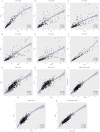Visceral obesity anthropometric indicators as predictors of acute pancreatitis severity
- PMID: 40718412
- PMCID: PMC12289579
- DOI: 10.3389/fmed.2025.1536090
Visceral obesity anthropometric indicators as predictors of acute pancreatitis severity
Abstract
Background: Acute pancreatitis (AP) severity assessment upon admission is crucial for prognosis, yet existing clinical scoring systems have limitations like delayed results, complexity, or low sensitivity. Obesity correlates with AP severity, but traditional body mass index (BMI) fails to accurately reflect visceral fat distribution. Although anthropometric indicators for visceral obesity offer alternatives, their predictive value for AP severity across all etiologies is poorly studied.
Methods: This retrospective cohort study analyzed 629 AP patients admitted to a tertiary hospital (2016-2023). Patients were classified as mild AP (MAP, n = 531) or moderately severe/severe AP (MSAP/SAP, n = 98) based on organ failure (modified Marshall score ≥ 2). Eleven anthropometric indicators and six clinical scoring systems were evaluated. Patients were randomly divided into training group (n = 441) and validation group (n = 188). LASSO regression identified key predictors from 37 clinical variables. Six machine learning (ML) models were built and evaluated using receiver operating characteristic (ROC) analysis, area under the ROC curve (AUC), calibration curves, and decision curve analysis (DCA).
Results: Nine anthropometric indicators [waist circumference, body roundness index, BMI, conicity index, lipid accumulation products (LAP), waist triglyceride index (WTI), cardiometabolic index (CMI), visceral adiposity index (VAI), chinese visceral adiposity index] and all clinical scoring systems (Ranson score, Glasgow score, SIRS, BISAP, APACHE II, JSS) significantly differed between MAP and MSAP/SAP groups (p < 0.05). VAI demonstrated the highest predictive AUC among anthropometric indicators (0.737 vs. SIRS 0.750, JSS 0.815), but superior to Ranson score, Glasgow score, BISAP, and APACHE II. LAP, WTI, and CMI also showed strong AUCs (0.729, 0.722, 0.736 respectively). LASSO selected 15 variables. Among ML models, XGBoost model performed best on the validation group (AUC = 0.878), and relatively good calibration curve and DCA results.
Conclusion: VAI, CMI, LAP, and WTI are independent predictors of AP severity, with VAI showing the highest individual predictive capability among them. The XGBoost model, incorporating VAI and routinely available clinical variables, achieved excellent performance (AUC = 0.878) for early severity assessment, offering a potentially rapid and cost-effective clinical tool. This supports the utility of visceral obesity anthropometric indicators and ML models for improving early risk stratification in AP.
Keywords: acute pancreatitis; anthropometric indicator; machine learning algorithm; organ failure; severity; visceral adiposity index.
Copyright © 2025 Gu, Shang and Wang.
Conflict of interest statement
The authors declare that the research was conducted in the absence of any commercial or financial relationships that could be construed as a potential conflict of interest.
Figures







Similar articles
-
Association of visceral obesity indicators with prostate cancer: a cross-sectional study from Xinjiang.Front Oncol. 2025 Jul 9;15:1614743. doi: 10.3389/fonc.2025.1614743. eCollection 2025. Front Oncol. 2025. PMID: 40703555 Free PMC article.
-
Supervised Machine Learning Models for Predicting Sepsis-Associated Liver Injury in Patients With Sepsis: Development and Validation Study Based on a Multicenter Cohort Study.J Med Internet Res. 2025 May 26;27:e66733. doi: 10.2196/66733. J Med Internet Res. 2025. PMID: 40418571 Free PMC article.
-
A Clinical and Imaging-based Model for Distinguishing Mild From Moderately Severe/Severe Hypertriglyceridemic Acute Pancreatitis: Development and Validation.J Comput Assist Tomogr. 2025 Aug 6. doi: 10.1097/RCT.0000000000001791. Online ahead of print. J Comput Assist Tomogr. 2025. PMID: 40768342
-
Systemic pharmacological treatments for chronic plaque psoriasis: a network meta-analysis.Cochrane Database Syst Rev. 2021 Apr 19;4(4):CD011535. doi: 10.1002/14651858.CD011535.pub4. Cochrane Database Syst Rev. 2021. Update in: Cochrane Database Syst Rev. 2022 May 23;5:CD011535. doi: 10.1002/14651858.CD011535.pub5. PMID: 33871055 Free PMC article. Updated.
-
Cost-effectiveness of using prognostic information to select women with breast cancer for adjuvant systemic therapy.Health Technol Assess. 2006 Sep;10(34):iii-iv, ix-xi, 1-204. doi: 10.3310/hta10340. Health Technol Assess. 2006. PMID: 16959170
References
-
- Xiao AY, Tan ML, Wu LM, Asrani VM, Windsor JA, Yadav D, et al. Global incidence and mortality of pancreatic diseases: a systematic review, meta-analysis, and meta-regression of population-based cohort studies. Lancet Gastroenterol Hepatol. (2016) 1:45–55. doi: 10.1016/S2468-1253(16)30004-8, PMID: - DOI - PubMed
LinkOut - more resources
Full Text Sources
Research Materials
Miscellaneous

